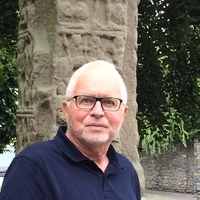Papers by David Ward-Perkins
Tourism cases, Jan 24, 2024
Tourism Cases, Feb 9, 2021
Introduction The Pankisi Valley case brings to the surface a number of interesting and related is... more Introduction The Pankisi Valley case brings to the surface a number of interesting and related issues relative to consumers’ perceptions of destinations and their host communities. We live in a complex world and our interpretation of distant countries tends to be shaped by the simplified messages of the 24-hour news cycle. A localized earthquake or a single terrorist attack can colour our views of a whole country, immediately and negatively affecting tourist attitudes and travel plans.
CABI eBooks, 2020
Abstract This chapter starts with an overview of early tourism, where the journey and route were ... more Abstract This chapter starts with an overview of early tourism, where the journey and route were of critical importance. It then discusses: the three essential tools and facilitators of route-focused tourism (tour operators, guides and guidebooks); the emergence of destination-focused tourism since the mid-20th century; the rise of the cultural destination in the 1990s; overtourism and the limits of destination-focused tourism; and the way forward for tourism. A case study of the Arctic Coast Way (Iceland) is presented, which illustrates how the rationale for creating an ambitious driving route is formulated and gives a good idea of the richness and complexity involved in its development.
Tourism Cases, Nov 28, 2022
In this case study, two students of events and tourism, coming to the end of their studies, durin... more In this case study, two students of events and tourism, coming to the end of their studies, during which they have learnt about the importance of innovation and the impact of digital technologies in the events industry, ask themselves how these issues are perceived in the real, day-to-day world of event management. They contact four recognised experts in the French event industry to question them about current trends and about the driving factors of change. Information Based on research and interviews conducted with French event professionals as part of a student project through Skema Business School. © CAB International 2022
Tourism Cases, Nov 1, 2020
Tourism Cases, Nov 1, 2020
Introduction This case recounts how Ghana Tourism Authority set up and managed a 2019 ‘year of re... more Introduction This case recounts how Ghana Tourism Authority set up and managed a 2019 ‘year of return’ with planned follow-up activities, exploiting a very particular form of diaspora tourism. The case should be studied alongside other examples of tourism that commemorate the exile of populations from their homelands.
Tourism Cases, Feb 9, 2021
Introduction Maggie’s enterprise is impressive in that she operates in a male-dominated field. Ev... more Introduction Maggie’s enterprise is impressive in that she operates in a male-dominated field. Even though women represent the majority of workers in the Tanzanian tourism industry, few of them occupy management or ownership positions. In 2018, women represented only 8% of Tanzanian’s CEOs ( Lionesses of Africa, 2021 ).
Tourism Cases, Nov 1, 2020
Introduction The interest in studying this case includes the long history of rural and wine touri... more Introduction The interest in studying this case includes the long history of rural and wine tourism in Alsace, led by a well-endowed and sophisticated tourism department. For researchers and students of wine tourism, it is therefore a good best-practice model. The Alsace case clearly demonstrates how wine tourism – apparently a niche product – has multiple links and tendrils, reaching into many other sectors. The case shows how these links can be made to work effectively, driving cultural tourism, cultural events, outdoor activities and other forms of tourism. It also shows how quality experiences keep their appeal despite changing fashions. In Alsace, some very traditional forms of tourism have morphed into fashionable leisure activities, under the label of ‘slow tourism.’
Tourism Cases, Nov 1, 2020
Introduction The question of carrying capacity is one faced by many protected natural areas. It m... more Introduction The question of carrying capacity is one faced by many protected natural areas. It might appear simple: if the number of visitors is such that it risks damaging the environment or biodiversity, then that number should be restricted or the visitor flow modified. On closer examination, the issues raised are complex. How do you define ‘damage’? How do you establish that a number is too high? Is it too high only at certain moments or in certain places? Can visitor behaviour be influenced? If one imposes restrictions, should all visitors be treated alike, or should some have priority? The more we consider carrying capacity, the more we realize that it is connected to many other issues. The case of Arches gives us an insight, therefore, on how a National Park Authority approaches visitor management as a whole.

Tourism Cases, Nov 1, 2020
Introduction Wherever economic interests are at play in natural areas, indigenous communities may... more Introduction Wherever economic interests are at play in natural areas, indigenous communities may find themselves at a disadvantage, struggling to maintain the balance they have historically enjoyed with their environment. This case describes how some communities of inland Viti Levu (Fiji), initially dependent on their relations with logging and gravel-extraction businesses, find a stronger, more independent voice. Tourism in the upper Navua River could simply have been an additional layer, unrelated to the concerns of the people of the Viti Levu highlands. However, the founders of Rivers Fiji Ltd. wanted to use their activity to bring some real benefit to the community, rather than exploit it. Through lobbying, persistence and the support of some influential allies, they helped effect some real changes. These actions have had the effect of handing greater control to the local communities and also, through the creation of a Conservation Area, bringing greater resilience to the natural environment of the Upper Navua River.
Tourism Cases, Feb 9, 2021

Tourism Cases, Nov 1, 2020
Introduction In the second half of the 20th century, many consumers became concerned about the in... more Introduction In the second half of the 20th century, many consumers became concerned about the increasing mechanization and standardization of food. At the same time, they were being exposed, through travel and global media, to food from around the world. These two influences have helped shape their perception of the countries concerned. The perception of the country or region’s food influences the choice of destination of many tourists. That region’s capacity to produce, prepare and serve quality food has become an important tourism asset. The world of tourism and the world of food production have now become, in many destinations, inextricably linked. Nowhere is this mix – this dependency of one on the other – more evident than in Catalonia, where the connection is made stronger by a reputation for high gastronomy, represented by chefs that are worldwide celebrities. This is an excellent case for study for those who seek to understand what a food hub is, and how this alchemy works.
Tourism Cases, Nov 1, 2020
Catalonia has been developing as a food hub for 25 to 30 years. The autonomous region’s ambition ... more Catalonia has been developing as a food hub for 25 to 30 years. The autonomous region’s ambition is to remain a world leader in the production and preparation of local food. Catalonia has demonstrated that a comprehensive food offer, with multiple components – farming practices, food processing, gastronomy and tourism promotion – can be transformative. This case study describes how. Information TEAM Tourism Consulting © CAB International 2020
Tourism Cases, Nov 1, 2020
Tourism Cases, Feb 9, 2021
Introduction In France, culture is seen as an economic driver and central government plays a role... more Introduction In France, culture is seen as an economic driver and central government plays a role in driving ambitious cultural initiatives, even at a regional level. This case describes how regional tourism authorities are overcoming the potential clash of perception between a newly established branch of the Louvre Museum in the town of Lens, in Nord-Pas-de-Calais, a region with a strong industrial and working-class culture. Researchers and students should note that a number of the sources are in French only. However, of the websites of the local authorities, some propose English-language versions; others are presented very visually and the messages will largely be understandable, even to non-French speakers.
Tourism Cases, Nov 1, 2020
Introduction A principal aim of the locavore movement is to reduce food-miles while giving consum... more Introduction A principal aim of the locavore movement is to reduce food-miles while giving consumers access to food that is of the region. Locally grown and locally raised food is of interest to tourists as it is a guarantee of authenticity, reflecting the landscapes and traditions of a place – in particular if it locally prepared at a food stand, in a restaurant or at a bed-and-breakfast.
Tourism Cases, Feb 9, 2021
Tourism Cases, Nov 1, 2020
Introduction The case is enlightening for researchers and students interested in exploring gender... more Introduction The case is enlightening for researchers and students interested in exploring gender roles in tourism, because it goes beyond the surface story – the inspiring initiative of Thinlas Chorol and the courage of her co-workers – to try and understand how these women perceive their role.

Tourism Cases, Jan 14, 2022
Introduction The case study is an example of what community-focused, sustainable tourism can look... more Introduction The case study is an example of what community-focused, sustainable tourism can look like. Costa Rica is known around the globe for its commitment to sustainable practices, and companies like Unique Adventures are a visible part of this larger sustainable model. In this case study, students can find practices and principles that relate to ecotourism, community-based tourism (CBT) and slow tourism. These correspond to the expectations and attitudes of an increasing proportion of tourists. Consequently, there is an ever-larger number of specialist agencies and operators that cater to this market. As introductory exercises, to become familiar with the subject, students can: Consult the websites of small businesses (in addition to Unique Adventures) and of specialized agencies, tour operators and guides. What are they promising and proposing? Through this online research, explore the different forms and formats of such tourism – including ecotourism, CBT and slow tourism. How can one define each? What do they have in common?
Tourism Cases, Nov 1, 2020











Uploads
Papers by David Ward-Perkins
territory are provided. The state of the art for Russian nature-based tourism is analysed through those cases. Then, an analysis is conducted to identify the current strengths and weaknesses of this Russian tourism, as well as opportunities and potential risks to consider, for Russia to improve its position as a nature-based tourism destination. The report concludes by offering strategic recommendations for future development, sustainable management, marketing, and guidelines to enhance human resource development through universities.